Comprehensive Report on Down Syndrome: Genetics, Symptoms & Treatment
VerifiedAdded on 2023/06/17
|8
|2440
|280
Report
AI Summary
This report delves into Down Syndrome, a genetic disorder caused by an extra chromosome 21. It discusses the inheritance patterns, distinguishing between trisomy 21, translocation, and mosaic Down Syndrome. The report outlines the symptoms, including developmental delays, distinctive facial features, and potential health issues like heart problems. Prognosis and life expectancy are addressed, along with the psychological implications, such as anxiety and neurodevelopmental concerns. Treatment interventions like genetic counseling, therapies (speech, occupational, physical), and medical treatments are explored. The report concludes by mentioning preventive methods and emphasizes the importance of early intervention and comprehensive care to improve the quality of life for individuals with Down Syndrome. Desklib offers similar solved assignments and past papers for students.
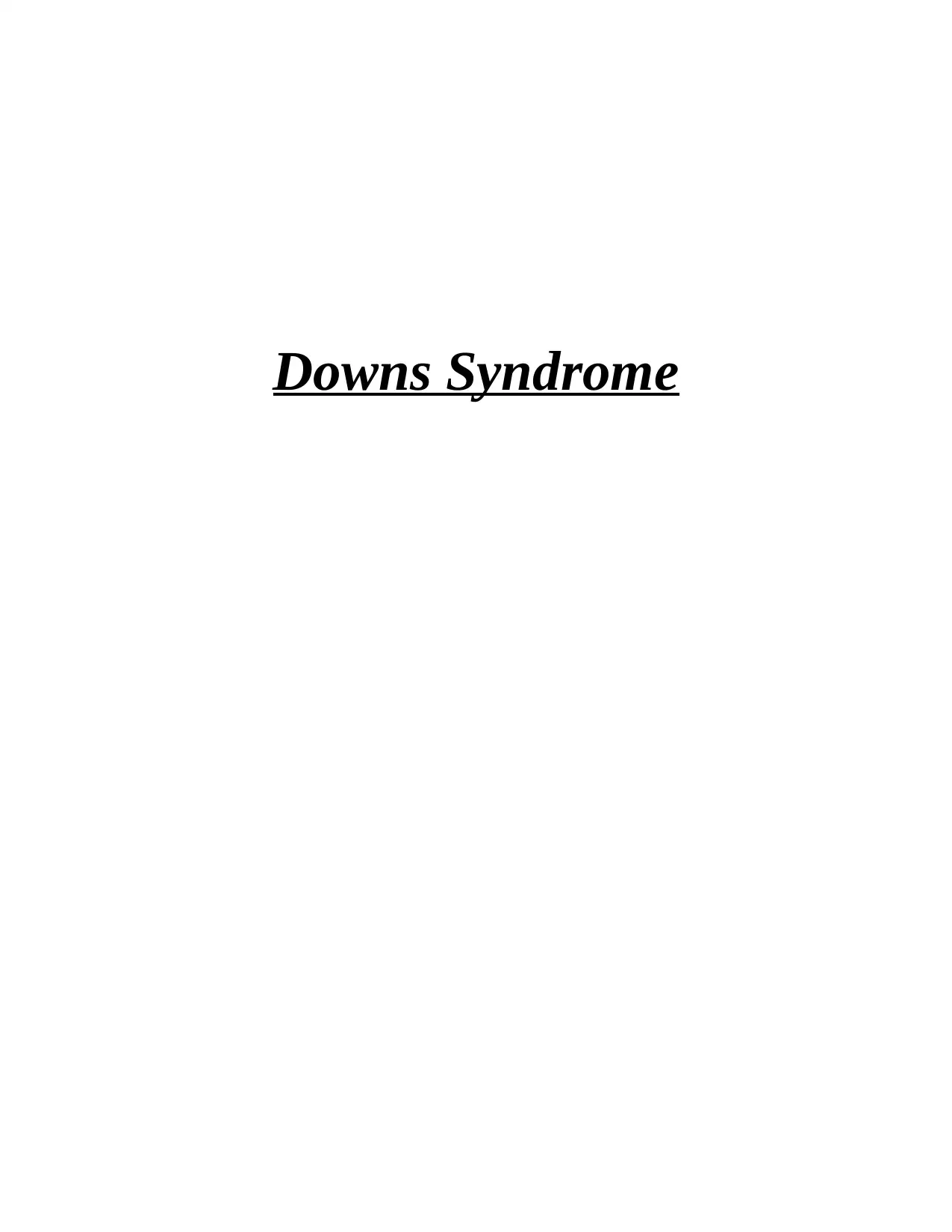
Downs Syndrome
Paraphrase This Document
Need a fresh take? Get an instant paraphrase of this document with our AI Paraphraser
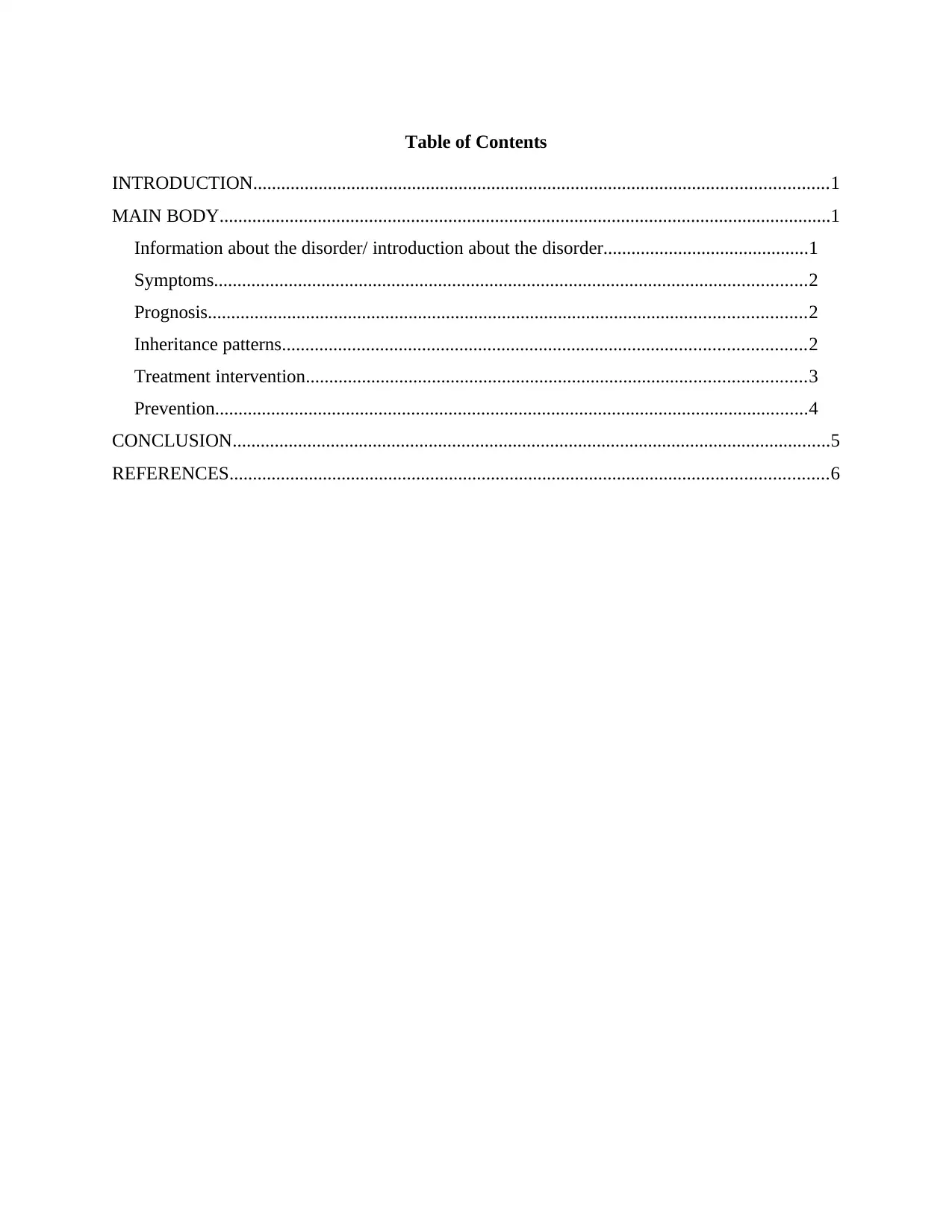
Table of Contents
INTRODUCTION...........................................................................................................................1
MAIN BODY...................................................................................................................................1
Information about the disorder/ introduction about the disorder............................................1
Symptoms...............................................................................................................................2
Prognosis................................................................................................................................2
Inheritance patterns................................................................................................................2
Treatment intervention...........................................................................................................3
Prevention...............................................................................................................................4
CONCLUSION................................................................................................................................5
REFERENCES................................................................................................................................6
INTRODUCTION...........................................................................................................................1
MAIN BODY...................................................................................................................................1
Information about the disorder/ introduction about the disorder............................................1
Symptoms...............................................................................................................................2
Prognosis................................................................................................................................2
Inheritance patterns................................................................................................................2
Treatment intervention...........................................................................................................3
Prevention...............................................................................................................................4
CONCLUSION................................................................................................................................5
REFERENCES................................................................................................................................6
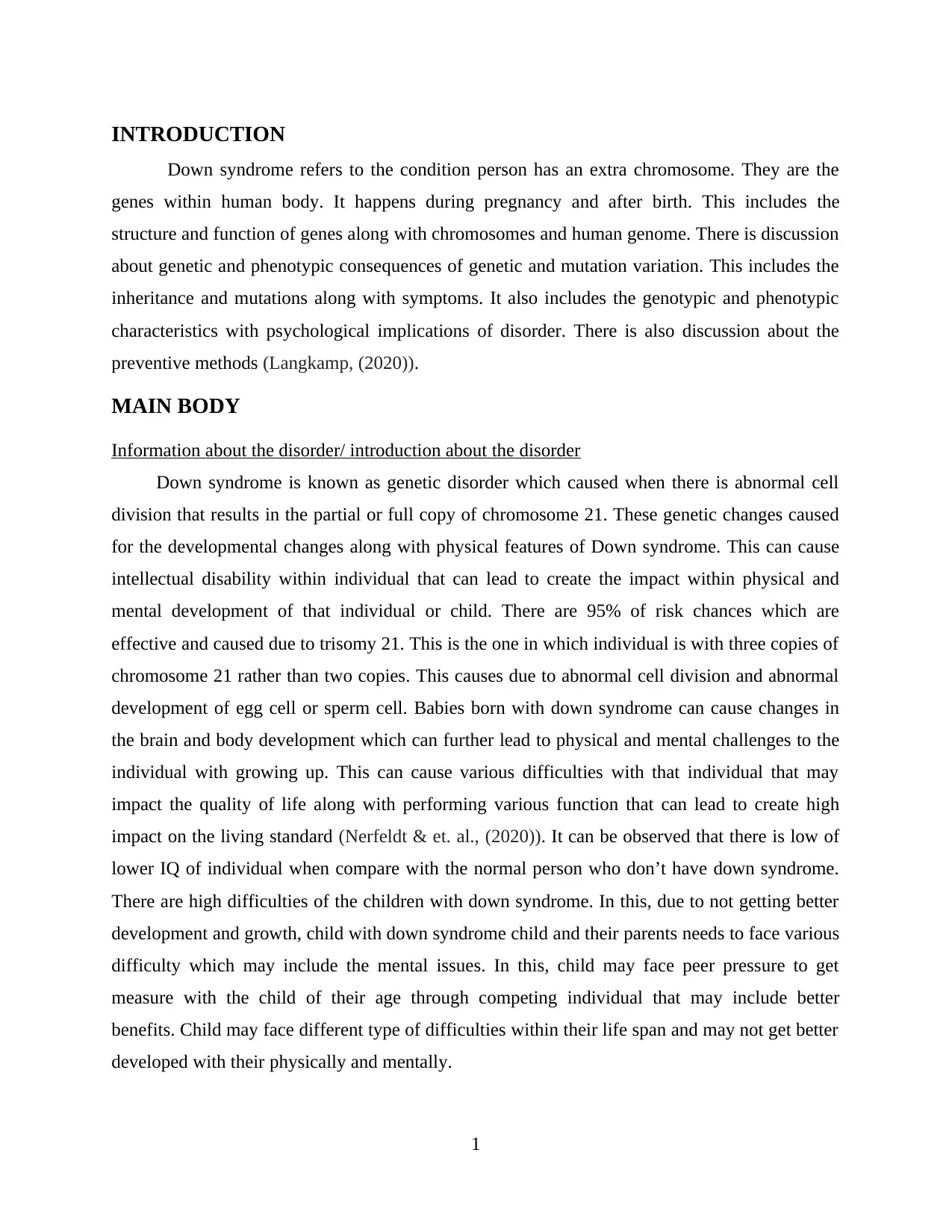
INTRODUCTION
Down syndrome refers to the condition person has an extra chromosome. They are the
genes within human body. It happens during pregnancy and after birth. This includes the
structure and function of genes along with chromosomes and human genome. There is discussion
about genetic and phenotypic consequences of genetic and mutation variation. This includes the
inheritance and mutations along with symptoms. It also includes the genotypic and phenotypic
characteristics with psychological implications of disorder. There is also discussion about the
preventive methods (Langkamp, (2020)).
MAIN BODY
Information about the disorder/ introduction about the disorder
Down syndrome is known as genetic disorder which caused when there is abnormal cell
division that results in the partial or full copy of chromosome 21. These genetic changes caused
for the developmental changes along with physical features of Down syndrome. This can cause
intellectual disability within individual that can lead to create the impact within physical and
mental development of that individual or child. There are 95% of risk chances which are
effective and caused due to trisomy 21. This is the one in which individual is with three copies of
chromosome 21 rather than two copies. This causes due to abnormal cell division and abnormal
development of egg cell or sperm cell. Babies born with down syndrome can cause changes in
the brain and body development which can further lead to physical and mental challenges to the
individual with growing up. This can cause various difficulties with that individual that may
impact the quality of life along with performing various function that can lead to create high
impact on the living standard (Nerfeldt & et. al., (2020)). It can be observed that there is low of
lower IQ of individual when compare with the normal person who don’t have down syndrome.
There are high difficulties of the children with down syndrome. In this, due to not getting better
development and growth, child with down syndrome child and their parents needs to face various
difficulty which may include the mental issues. In this, child may face peer pressure to get
measure with the child of their age through competing individual that may include better
benefits. Child may face different type of difficulties within their life span and may not get better
developed with their physically and mentally.
1
Down syndrome refers to the condition person has an extra chromosome. They are the
genes within human body. It happens during pregnancy and after birth. This includes the
structure and function of genes along with chromosomes and human genome. There is discussion
about genetic and phenotypic consequences of genetic and mutation variation. This includes the
inheritance and mutations along with symptoms. It also includes the genotypic and phenotypic
characteristics with psychological implications of disorder. There is also discussion about the
preventive methods (Langkamp, (2020)).
MAIN BODY
Information about the disorder/ introduction about the disorder
Down syndrome is known as genetic disorder which caused when there is abnormal cell
division that results in the partial or full copy of chromosome 21. These genetic changes caused
for the developmental changes along with physical features of Down syndrome. This can cause
intellectual disability within individual that can lead to create the impact within physical and
mental development of that individual or child. There are 95% of risk chances which are
effective and caused due to trisomy 21. This is the one in which individual is with three copies of
chromosome 21 rather than two copies. This causes due to abnormal cell division and abnormal
development of egg cell or sperm cell. Babies born with down syndrome can cause changes in
the brain and body development which can further lead to physical and mental challenges to the
individual with growing up. This can cause various difficulties with that individual that may
impact the quality of life along with performing various function that can lead to create high
impact on the living standard (Nerfeldt & et. al., (2020)). It can be observed that there is low of
lower IQ of individual when compare with the normal person who don’t have down syndrome.
There are high difficulties of the children with down syndrome. In this, due to not getting better
development and growth, child with down syndrome child and their parents needs to face various
difficulty which may include the mental issues. In this, child may face peer pressure to get
measure with the child of their age through competing individual that may include better
benefits. Child may face different type of difficulties within their life span and may not get better
developed with their physically and mentally.
1
⊘ This is a preview!⊘
Do you want full access?
Subscribe today to unlock all pages.

Trusted by 1+ million students worldwide
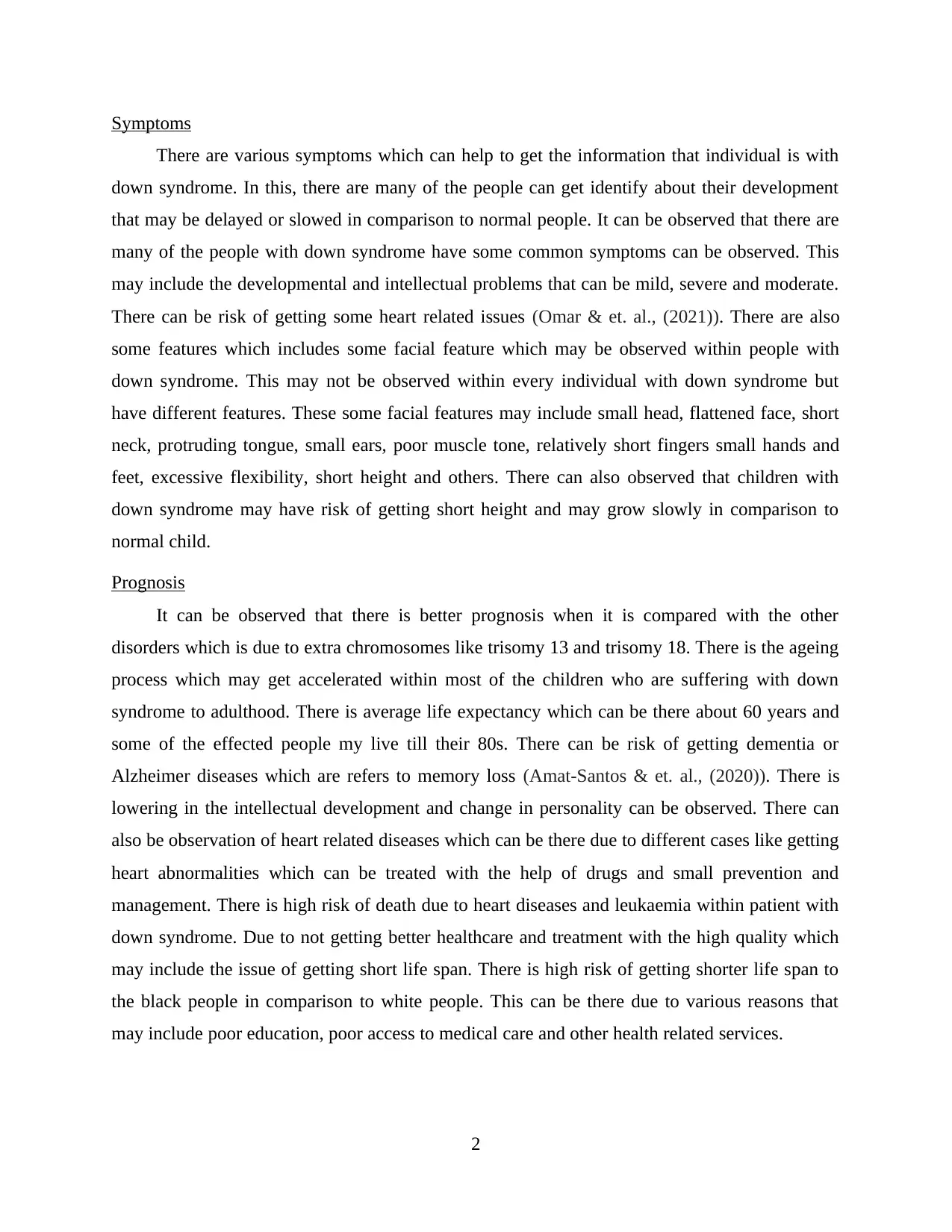
Symptoms
There are various symptoms which can help to get the information that individual is with
down syndrome. In this, there are many of the people can get identify about their development
that may be delayed or slowed in comparison to normal people. It can be observed that there are
many of the people with down syndrome have some common symptoms can be observed. This
may include the developmental and intellectual problems that can be mild, severe and moderate.
There can be risk of getting some heart related issues (Omar & et. al., (2021)). There are also
some features which includes some facial feature which may be observed within people with
down syndrome. This may not be observed within every individual with down syndrome but
have different features. These some facial features may include small head, flattened face, short
neck, protruding tongue, small ears, poor muscle tone, relatively short fingers small hands and
feet, excessive flexibility, short height and others. There can also observed that children with
down syndrome may have risk of getting short height and may grow slowly in comparison to
normal child.
Prognosis
It can be observed that there is better prognosis when it is compared with the other
disorders which is due to extra chromosomes like trisomy 13 and trisomy 18. There is the ageing
process which may get accelerated within most of the children who are suffering with down
syndrome to adulthood. There is average life expectancy which can be there about 60 years and
some of the effected people my live till their 80s. There can be risk of getting dementia or
Alzheimer diseases which are refers to memory loss (Amat-Santos & et. al., (2020)). There is
lowering in the intellectual development and change in personality can be observed. There can
also be observation of heart related diseases which can be there due to different cases like getting
heart abnormalities which can be treated with the help of drugs and small prevention and
management. There is high risk of death due to heart diseases and leukaemia within patient with
down syndrome. Due to not getting better healthcare and treatment with the high quality which
may include the issue of getting short life span. There is high risk of getting shorter life span to
the black people in comparison to white people. This can be there due to various reasons that
may include poor education, poor access to medical care and other health related services.
2
There are various symptoms which can help to get the information that individual is with
down syndrome. In this, there are many of the people can get identify about their development
that may be delayed or slowed in comparison to normal people. It can be observed that there are
many of the people with down syndrome have some common symptoms can be observed. This
may include the developmental and intellectual problems that can be mild, severe and moderate.
There can be risk of getting some heart related issues (Omar & et. al., (2021)). There are also
some features which includes some facial feature which may be observed within people with
down syndrome. This may not be observed within every individual with down syndrome but
have different features. These some facial features may include small head, flattened face, short
neck, protruding tongue, small ears, poor muscle tone, relatively short fingers small hands and
feet, excessive flexibility, short height and others. There can also observed that children with
down syndrome may have risk of getting short height and may grow slowly in comparison to
normal child.
Prognosis
It can be observed that there is better prognosis when it is compared with the other
disorders which is due to extra chromosomes like trisomy 13 and trisomy 18. There is the ageing
process which may get accelerated within most of the children who are suffering with down
syndrome to adulthood. There is average life expectancy which can be there about 60 years and
some of the effected people my live till their 80s. There can be risk of getting dementia or
Alzheimer diseases which are refers to memory loss (Amat-Santos & et. al., (2020)). There is
lowering in the intellectual development and change in personality can be observed. There can
also be observation of heart related diseases which can be there due to different cases like getting
heart abnormalities which can be treated with the help of drugs and small prevention and
management. There is high risk of death due to heart diseases and leukaemia within patient with
down syndrome. Due to not getting better healthcare and treatment with the high quality which
may include the issue of getting short life span. There is high risk of getting shorter life span to
the black people in comparison to white people. This can be there due to various reasons that
may include poor education, poor access to medical care and other health related services.
2
Paraphrase This Document
Need a fresh take? Get an instant paraphrase of this document with our AI Paraphraser
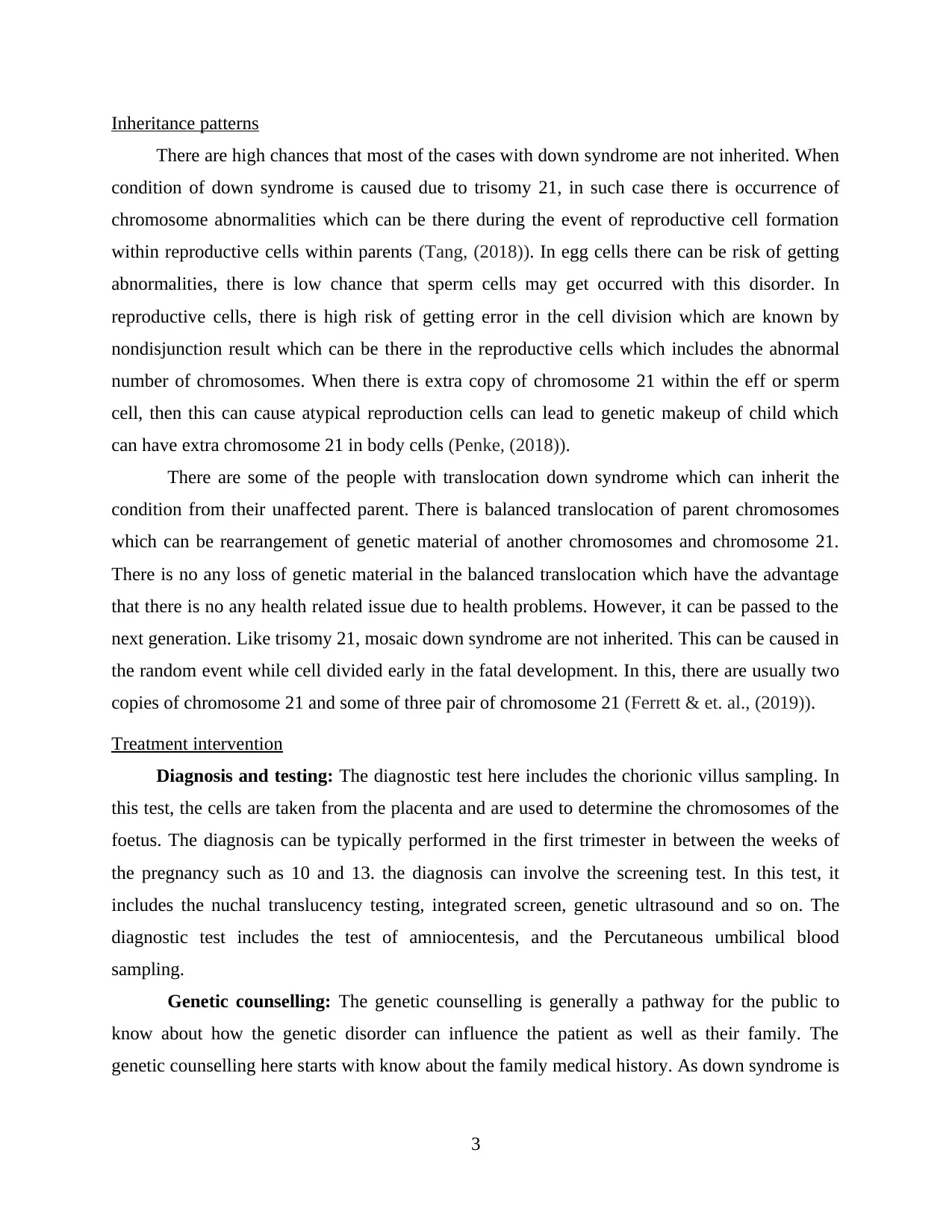
Inheritance patterns
There are high chances that most of the cases with down syndrome are not inherited. When
condition of down syndrome is caused due to trisomy 21, in such case there is occurrence of
chromosome abnormalities which can be there during the event of reproductive cell formation
within reproductive cells within parents (Tang, (2018)). In egg cells there can be risk of getting
abnormalities, there is low chance that sperm cells may get occurred with this disorder. In
reproductive cells, there is high risk of getting error in the cell division which are known by
nondisjunction result which can be there in the reproductive cells which includes the abnormal
number of chromosomes. When there is extra copy of chromosome 21 within the eff or sperm
cell, then this can cause atypical reproduction cells can lead to genetic makeup of child which
can have extra chromosome 21 in body cells (Penke, (2018)).
There are some of the people with translocation down syndrome which can inherit the
condition from their unaffected parent. There is balanced translocation of parent chromosomes
which can be rearrangement of genetic material of another chromosomes and chromosome 21.
There is no any loss of genetic material in the balanced translocation which have the advantage
that there is no any health related issue due to health problems. However, it can be passed to the
next generation. Like trisomy 21, mosaic down syndrome are not inherited. This can be caused in
the random event while cell divided early in the fatal development. In this, there are usually two
copies of chromosome 21 and some of three pair of chromosome 21 (Ferrett & et. al., (2019)).
Treatment intervention
Diagnosis and testing: The diagnostic test here includes the chorionic villus sampling. In
this test, the cells are taken from the placenta and are used to determine the chromosomes of the
foetus. The diagnosis can be typically performed in the first trimester in between the weeks of
the pregnancy such as 10 and 13. the diagnosis can involve the screening test. In this test, it
includes the nuchal translucency testing, integrated screen, genetic ultrasound and so on. The
diagnostic test includes the test of amniocentesis, and the Percutaneous umbilical blood
sampling.
Genetic counselling: The genetic counselling is generally a pathway for the public to
know about how the genetic disorder can influence the patient as well as their family. The
genetic counselling here starts with know about the family medical history. As down syndrome is
3
There are high chances that most of the cases with down syndrome are not inherited. When
condition of down syndrome is caused due to trisomy 21, in such case there is occurrence of
chromosome abnormalities which can be there during the event of reproductive cell formation
within reproductive cells within parents (Tang, (2018)). In egg cells there can be risk of getting
abnormalities, there is low chance that sperm cells may get occurred with this disorder. In
reproductive cells, there is high risk of getting error in the cell division which are known by
nondisjunction result which can be there in the reproductive cells which includes the abnormal
number of chromosomes. When there is extra copy of chromosome 21 within the eff or sperm
cell, then this can cause atypical reproduction cells can lead to genetic makeup of child which
can have extra chromosome 21 in body cells (Penke, (2018)).
There are some of the people with translocation down syndrome which can inherit the
condition from their unaffected parent. There is balanced translocation of parent chromosomes
which can be rearrangement of genetic material of another chromosomes and chromosome 21.
There is no any loss of genetic material in the balanced translocation which have the advantage
that there is no any health related issue due to health problems. However, it can be passed to the
next generation. Like trisomy 21, mosaic down syndrome are not inherited. This can be caused in
the random event while cell divided early in the fatal development. In this, there are usually two
copies of chromosome 21 and some of three pair of chromosome 21 (Ferrett & et. al., (2019)).
Treatment intervention
Diagnosis and testing: The diagnostic test here includes the chorionic villus sampling. In
this test, the cells are taken from the placenta and are used to determine the chromosomes of the
foetus. The diagnosis can be typically performed in the first trimester in between the weeks of
the pregnancy such as 10 and 13. the diagnosis can involve the screening test. In this test, it
includes the nuchal translucency testing, integrated screen, genetic ultrasound and so on. The
diagnostic test includes the test of amniocentesis, and the Percutaneous umbilical blood
sampling.
Genetic counselling: The genetic counselling is generally a pathway for the public to
know about how the genetic disorder can influence the patient as well as their family. The
genetic counselling here starts with know about the family medical history. As down syndrome is
3
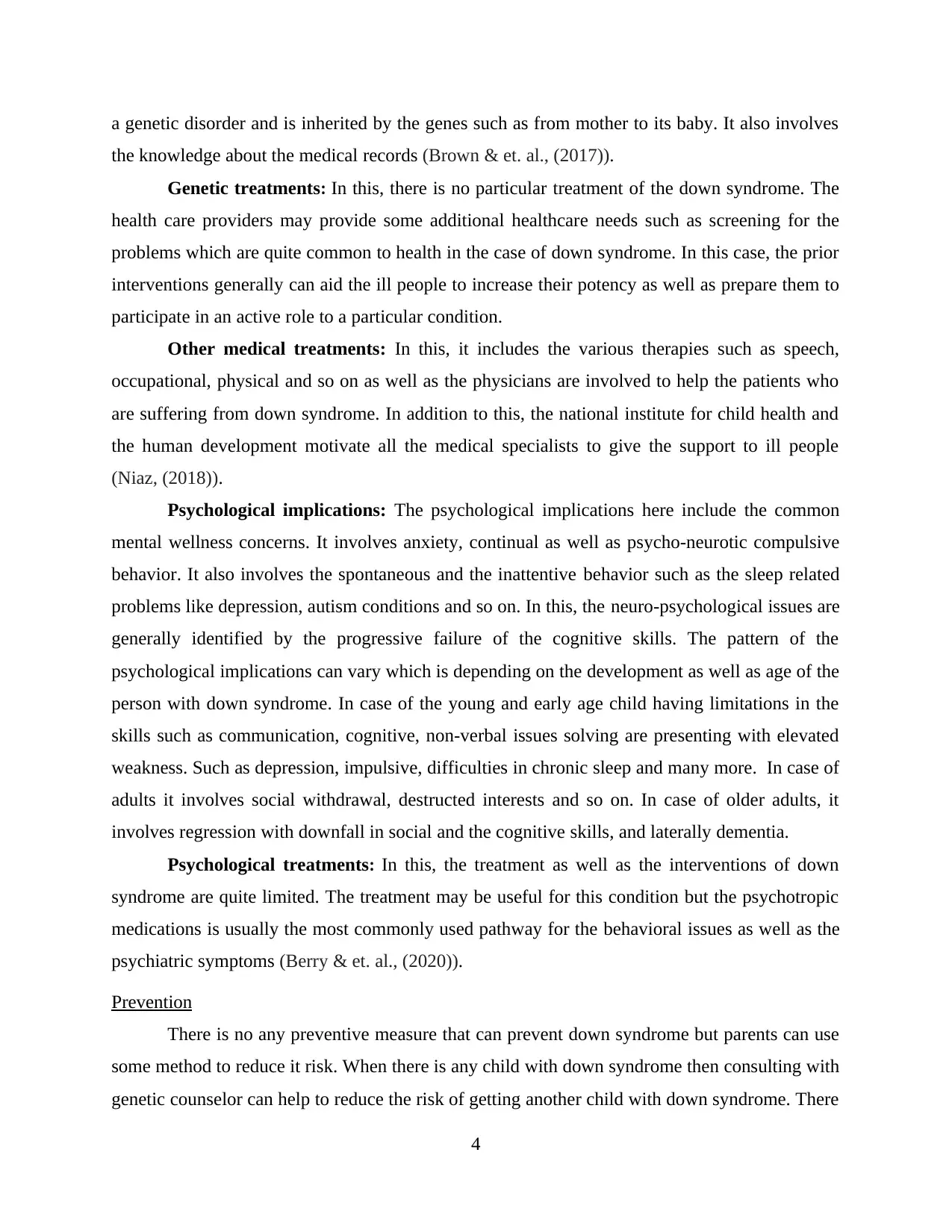
a genetic disorder and is inherited by the genes such as from mother to its baby. It also involves
the knowledge about the medical records (Brown & et. al., (2017)).
Genetic treatments: In this, there is no particular treatment of the down syndrome. The
health care providers may provide some additional healthcare needs such as screening for the
problems which are quite common to health in the case of down syndrome. In this case, the prior
interventions generally can aid the ill people to increase their potency as well as prepare them to
participate in an active role to a particular condition.
Other medical treatments: In this, it includes the various therapies such as speech,
occupational, physical and so on as well as the physicians are involved to help the patients who
are suffering from down syndrome. In addition to this, the national institute for child health and
the human development motivate all the medical specialists to give the support to ill people
(Niaz, (2018)).
Psychological implications: The psychological implications here include the common
mental wellness concerns. It involves anxiety, continual as well as psycho-neurotic compulsive
behavior. It also involves the spontaneous and the inattentive behavior such as the sleep related
problems like depression, autism conditions and so on. In this, the neuro-psychological issues are
generally identified by the progressive failure of the cognitive skills. The pattern of the
psychological implications can vary which is depending on the development as well as age of the
person with down syndrome. In case of the young and early age child having limitations in the
skills such as communication, cognitive, non-verbal issues solving are presenting with elevated
weakness. Such as depression, impulsive, difficulties in chronic sleep and many more. In case of
adults it involves social withdrawal, destructed interests and so on. In case of older adults, it
involves regression with downfall in social and the cognitive skills, and laterally dementia.
Psychological treatments: In this, the treatment as well as the interventions of down
syndrome are quite limited. The treatment may be useful for this condition but the psychotropic
medications is usually the most commonly used pathway for the behavioral issues as well as the
psychiatric symptoms (Berry & et. al., (2020)).
Prevention
There is no any preventive measure that can prevent down syndrome but parents can use
some method to reduce it risk. When there is any child with down syndrome then consulting with
genetic counselor can help to reduce the risk of getting another child with down syndrome. There
4
the knowledge about the medical records (Brown & et. al., (2017)).
Genetic treatments: In this, there is no particular treatment of the down syndrome. The
health care providers may provide some additional healthcare needs such as screening for the
problems which are quite common to health in the case of down syndrome. In this case, the prior
interventions generally can aid the ill people to increase their potency as well as prepare them to
participate in an active role to a particular condition.
Other medical treatments: In this, it includes the various therapies such as speech,
occupational, physical and so on as well as the physicians are involved to help the patients who
are suffering from down syndrome. In addition to this, the national institute for child health and
the human development motivate all the medical specialists to give the support to ill people
(Niaz, (2018)).
Psychological implications: The psychological implications here include the common
mental wellness concerns. It involves anxiety, continual as well as psycho-neurotic compulsive
behavior. It also involves the spontaneous and the inattentive behavior such as the sleep related
problems like depression, autism conditions and so on. In this, the neuro-psychological issues are
generally identified by the progressive failure of the cognitive skills. The pattern of the
psychological implications can vary which is depending on the development as well as age of the
person with down syndrome. In case of the young and early age child having limitations in the
skills such as communication, cognitive, non-verbal issues solving are presenting with elevated
weakness. Such as depression, impulsive, difficulties in chronic sleep and many more. In case of
adults it involves social withdrawal, destructed interests and so on. In case of older adults, it
involves regression with downfall in social and the cognitive skills, and laterally dementia.
Psychological treatments: In this, the treatment as well as the interventions of down
syndrome are quite limited. The treatment may be useful for this condition but the psychotropic
medications is usually the most commonly used pathway for the behavioral issues as well as the
psychiatric symptoms (Berry & et. al., (2020)).
Prevention
There is no any preventive measure that can prevent down syndrome but parents can use
some method to reduce it risk. When there is any child with down syndrome then consulting with
genetic counselor can help to reduce the risk of getting another child with down syndrome. There
4
⊘ This is a preview!⊘
Do you want full access?
Subscribe today to unlock all pages.

Trusted by 1+ million students worldwide
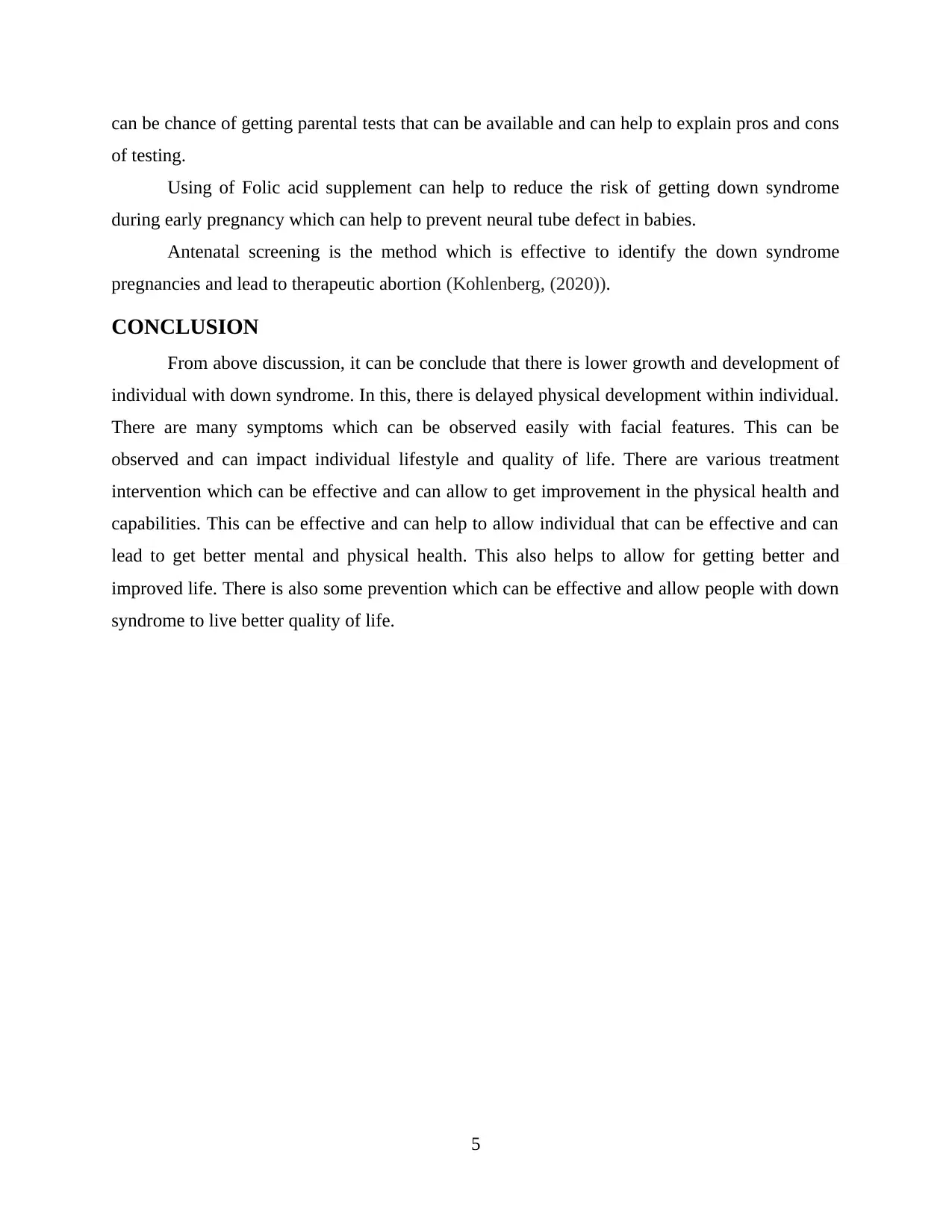
can be chance of getting parental tests that can be available and can help to explain pros and cons
of testing.
Using of Folic acid supplement can help to reduce the risk of getting down syndrome
during early pregnancy which can help to prevent neural tube defect in babies.
Antenatal screening is the method which is effective to identify the down syndrome
pregnancies and lead to therapeutic abortion (Kohlenberg, (2020)).
CONCLUSION
From above discussion, it can be conclude that there is lower growth and development of
individual with down syndrome. In this, there is delayed physical development within individual.
There are many symptoms which can be observed easily with facial features. This can be
observed and can impact individual lifestyle and quality of life. There are various treatment
intervention which can be effective and can allow to get improvement in the physical health and
capabilities. This can be effective and can help to allow individual that can be effective and can
lead to get better mental and physical health. This also helps to allow for getting better and
improved life. There is also some prevention which can be effective and allow people with down
syndrome to live better quality of life.
5
of testing.
Using of Folic acid supplement can help to reduce the risk of getting down syndrome
during early pregnancy which can help to prevent neural tube defect in babies.
Antenatal screening is the method which is effective to identify the down syndrome
pregnancies and lead to therapeutic abortion (Kohlenberg, (2020)).
CONCLUSION
From above discussion, it can be conclude that there is lower growth and development of
individual with down syndrome. In this, there is delayed physical development within individual.
There are many symptoms which can be observed easily with facial features. This can be
observed and can impact individual lifestyle and quality of life. There are various treatment
intervention which can be effective and can allow to get improvement in the physical health and
capabilities. This can be effective and can help to allow individual that can be effective and can
lead to get better mental and physical health. This also helps to allow for getting better and
improved life. There is also some prevention which can be effective and allow people with down
syndrome to live better quality of life.
5
Paraphrase This Document
Need a fresh take? Get an instant paraphrase of this document with our AI Paraphraser
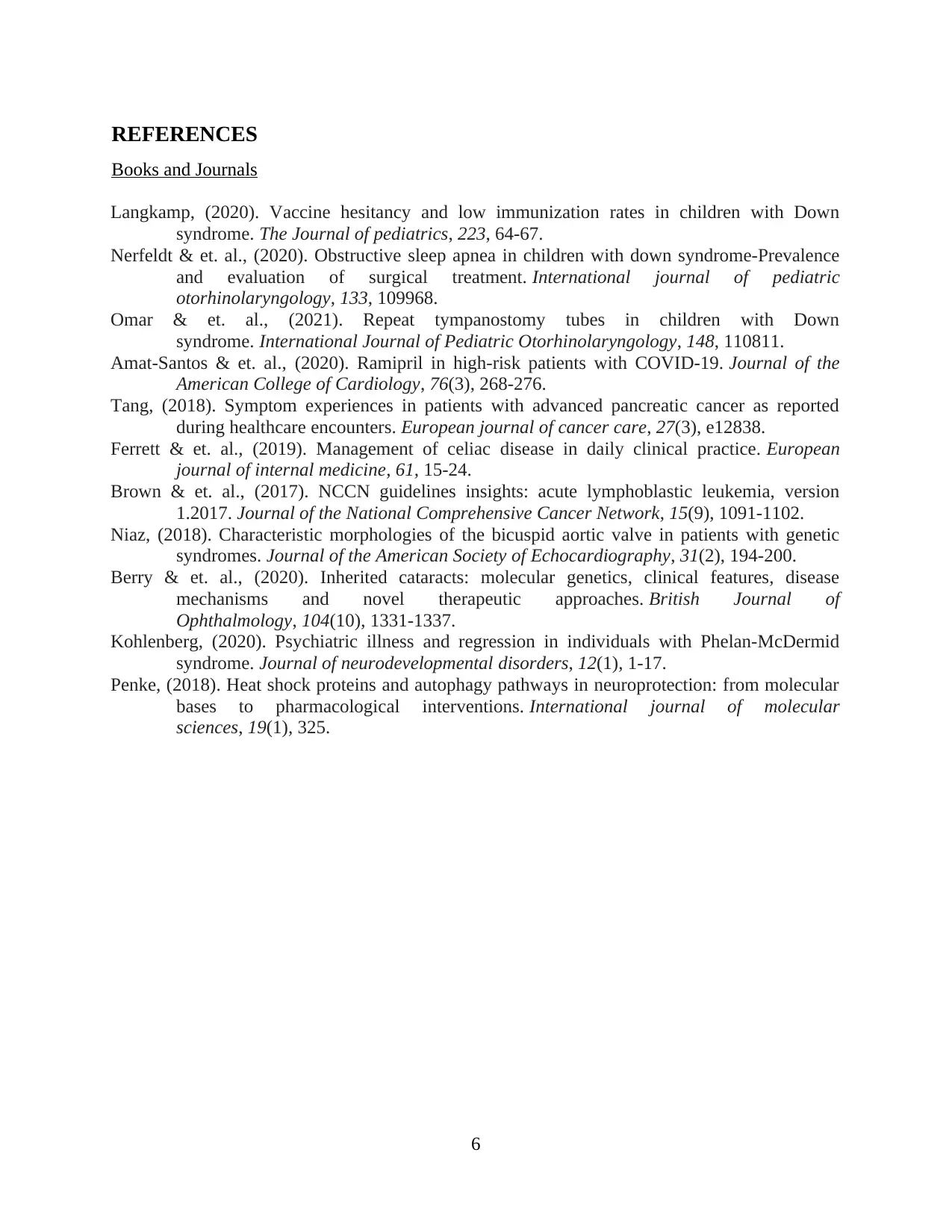
REFERENCES
Books and Journals
Langkamp, (2020). Vaccine hesitancy and low immunization rates in children with Down
syndrome. The Journal of pediatrics, 223, 64-67.
Nerfeldt & et. al., (2020). Obstructive sleep apnea in children with down syndrome-Prevalence
and evaluation of surgical treatment. International journal of pediatric
otorhinolaryngology, 133, 109968.
Omar & et. al., (2021). Repeat tympanostomy tubes in children with Down
syndrome. International Journal of Pediatric Otorhinolaryngology, 148, 110811.
Amat-Santos & et. al., (2020). Ramipril in high-risk patients with COVID-19. Journal of the
American College of Cardiology, 76(3), 268-276.
Tang, (2018). Symptom experiences in patients with advanced pancreatic cancer as reported
during healthcare encounters. European journal of cancer care, 27(3), e12838.
Ferrett & et. al., (2019). Management of celiac disease in daily clinical practice. European
journal of internal medicine, 61, 15-24.
Brown & et. al., (2017). NCCN guidelines insights: acute lymphoblastic leukemia, version
1.2017. Journal of the National Comprehensive Cancer Network, 15(9), 1091-1102.
Niaz, (2018). Characteristic morphologies of the bicuspid aortic valve in patients with genetic
syndromes. Journal of the American Society of Echocardiography, 31(2), 194-200.
Berry & et. al., (2020). Inherited cataracts: molecular genetics, clinical features, disease
mechanisms and novel therapeutic approaches. British Journal of
Ophthalmology, 104(10), 1331-1337.
Kohlenberg, (2020). Psychiatric illness and regression in individuals with Phelan-McDermid
syndrome. Journal of neurodevelopmental disorders, 12(1), 1-17.
Penke, (2018). Heat shock proteins and autophagy pathways in neuroprotection: from molecular
bases to pharmacological interventions. International journal of molecular
sciences, 19(1), 325.
6
Books and Journals
Langkamp, (2020). Vaccine hesitancy and low immunization rates in children with Down
syndrome. The Journal of pediatrics, 223, 64-67.
Nerfeldt & et. al., (2020). Obstructive sleep apnea in children with down syndrome-Prevalence
and evaluation of surgical treatment. International journal of pediatric
otorhinolaryngology, 133, 109968.
Omar & et. al., (2021). Repeat tympanostomy tubes in children with Down
syndrome. International Journal of Pediatric Otorhinolaryngology, 148, 110811.
Amat-Santos & et. al., (2020). Ramipril in high-risk patients with COVID-19. Journal of the
American College of Cardiology, 76(3), 268-276.
Tang, (2018). Symptom experiences in patients with advanced pancreatic cancer as reported
during healthcare encounters. European journal of cancer care, 27(3), e12838.
Ferrett & et. al., (2019). Management of celiac disease in daily clinical practice. European
journal of internal medicine, 61, 15-24.
Brown & et. al., (2017). NCCN guidelines insights: acute lymphoblastic leukemia, version
1.2017. Journal of the National Comprehensive Cancer Network, 15(9), 1091-1102.
Niaz, (2018). Characteristic morphologies of the bicuspid aortic valve in patients with genetic
syndromes. Journal of the American Society of Echocardiography, 31(2), 194-200.
Berry & et. al., (2020). Inherited cataracts: molecular genetics, clinical features, disease
mechanisms and novel therapeutic approaches. British Journal of
Ophthalmology, 104(10), 1331-1337.
Kohlenberg, (2020). Psychiatric illness and regression in individuals with Phelan-McDermid
syndrome. Journal of neurodevelopmental disorders, 12(1), 1-17.
Penke, (2018). Heat shock proteins and autophagy pathways in neuroprotection: from molecular
bases to pharmacological interventions. International journal of molecular
sciences, 19(1), 325.
6
1 out of 8
Related Documents
Your All-in-One AI-Powered Toolkit for Academic Success.
+13062052269
info@desklib.com
Available 24*7 on WhatsApp / Email
![[object Object]](/_next/static/media/star-bottom.7253800d.svg)
Unlock your academic potential
Copyright © 2020–2025 A2Z Services. All Rights Reserved. Developed and managed by ZUCOL.





